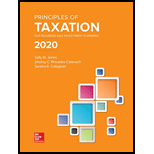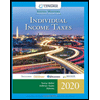
Explain the way tax payments differ from other payments that people or organizations make to governmental agencies.
Explanation of Solution
The Tax: As defined by IRS the tax is “an enforced contribution, exacted pursuant to legislative authority in the exercise of the taxing power, and imposed and collected for the purpose of raising revenue to be used for public or governmental purposes. Taxes are not payments for some special privilege granted or service rendered and are, therefore, distinguishable from various other charges imposed for particular purposes under particular powers or functions of government.”
As defined, the tax payments are mandatory payments from all eligible taxpayers mobilizing revenue for the government, for its use for the public as a whole. Unlike any fines and penalties that are punishable act by the government, tax payments are made to meet the tax obligations by the taxpayers. Unlike fess, like driving license fee or stamp duty, the tax payments cannot be attributed to any specific cause or benefit. Tax payments differs from fees and other government payment, as it is compulsory and mandatory for the taxpayer to pay their tax due in time.
Want to see more full solutions like this?
Chapter 1 Solutions
PRINCIPLES OF TAXATION F/BUS...(LL)
- Brightview Components Ltd. expected an overhead cost of $425,000 for its packaging cost pool and an estimated 17,000 packaging operations. The actual overhead cost for that cost pool was $460,000for 18,200 actual packaging operations. The activity-based overhead rate (ABOR) used to assign the costs of the packaging cost pool to products is __arrow_forwardElba Industries recently reported an EBITDA of $12.5 million and a net income of $3.7 million. It had $3.2 million in interest expense, and its corporate taxrate was 40%. What was its charge for depreciation and amortization?arrow_forwardPedro Manufacturing expects overhead costs of $360,000 per year and direct production costs of $15 per unit. The estimated production activity for the 2023 accounting period is as follows: 1st 2nd 3rd 4th Quarter Units Produced 10,000 9,500 8,000 10,500| The predetermined overhead rate based on units produced is (rounded to the nearest penny): a. $9.47 per unit b. $10.00 per unit c. $8.05 per unit d. $11.25 per unitarrow_forward
- Please provide the accurate answer to this general accounting problem using valid techniques.arrow_forwardHello tutor please given General accounting question answer do fast and properly explain all answerarrow_forwardOn March 1, 20X1, your company,which uses Units-of-Production (UOP) Depreciation, purchases a machine for $300,000.arrow_forward
 Individual Income TaxesAccountingISBN:9780357109731Author:HoffmanPublisher:CENGAGE LEARNING - CONSIGNMENT
Individual Income TaxesAccountingISBN:9780357109731Author:HoffmanPublisher:CENGAGE LEARNING - CONSIGNMENT EBK CONTEMPORARY FINANCIAL MANAGEMENTFinanceISBN:9781337514835Author:MOYERPublisher:CENGAGE LEARNING - CONSIGNMENT
EBK CONTEMPORARY FINANCIAL MANAGEMENTFinanceISBN:9781337514835Author:MOYERPublisher:CENGAGE LEARNING - CONSIGNMENT





